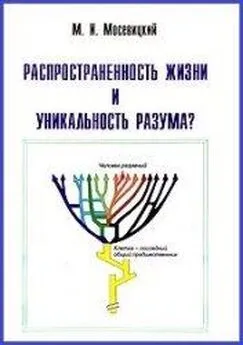Марк Мосевицкий - Распространненость жизни и уникальность разума?
- Название:Распространненость жизни и уникальность разума?
- Автор:
- Жанр:
- Издательство:ПИЯФ РАН
- Год:2008
- Город:Санкт-Петербург
- ISBN:5-86763-203-2
- Рейтинг:
- Избранное:Добавить в избранное
-
Отзывы:
-
Ваша оценка:
Марк Мосевицкий - Распространненость жизни и уникальность разума? краткое содержание
Исследование самых ранних осадочных пород показывает, что клеточные формы жизни присутствовали на Земле около 3.85 млрд лет тому назад, т. е. появились вскоре после создания совместимых с жизнью условий. Это означает, что доклеточная эволюция при всей ее сложности могла быть осуществлена в очень короткий срок (10–50 млн лет). Согласно другой версии, доклеточная эволюция происходила вне Земли (панспермия). В любом случае пример Земли позволяет предполагать широкое распространение жизни везде, где созданы подходящие для ее развития условия. С другой стороны, палеонтологическая летопись, начатая около 3.5 млрд лет тому назад, позволила выявить многочисленные кризисы (вымирания), приводившие к крутым разворотам в ходе эволюционного процесса. В основе эволюционных кризисов лежали природные катастрофы, вызванные падениями астероидов, глобальными оледенениями, длительными (в течение миллионов лет) истечениями лавы, изменениями газового баланса в океане и атмосфере. Бесчисленные воздействия на эволюцию оказывали также происходившие спонтанно мутации и горизонтальные обмены генетическим материалом. Благодаря наложению большого числа случайных факторов эволюционный процесс каждый раз является уникальным. На Земле после почти 4-х млрд лет существования жизни эволюционный процесс дал единственную ведущую к разуму ветвь гоминин (прямоходящих наследников шимпанзе). После многих критических ситуаций на этой ветви сохранился один побег – современное человечество. Отсутствие признаков существования других цивилизаций в доступном для общения космосе подтверждает весьма низкую вероятность выхода эволюции на маршрут, ведущий к разуму. Понимание природы кризисных событий, имевших место на Земле в прошлом, необходимо для того, чтобы, опираясь на все возрастающие возможности человечества, предотвратить наступление этих событий в будущем или хотя бы смягчить их последствия. Основной материал доступен широкому кругу читателей. Автор стремился также сделать книгу интересной для специалистов. Этим, в частности, объясняется большое число ссылок на последние публикации в научных журналах.
Распространненость жизни и уникальность разума? - читать онлайн бесплатно ознакомительный отрывок
Интервал:
Закладка:
Hanczyc M. M. and Szostak J. W. (2004) Replicating vesicles as models of primitive cell growth and division. Curr. Opin. Chem. Biol., 8, 660―664.
Harcourt-Smith W. E. and Aiello L. C. (2004) Fossils, feet and the evolution of human bipedal locomotion. J. Anat., 204, 403―416.
Harris J. K. et al. (2003) The genetic core of the universal ancestor. Genome Res., 13, 407―412.
Hartman H. and Fedorov A. (2002) The origin of the eukariotic cell: a genomic investigation. Proc. Natl. Acad. Sci. USA, 99, 1420―1425.
Hasegawa M. and Hashimoto T. (1999) Phylogenetic position of amitochondriate Protists in the evolution of eucaryotes. Biol. Bull., 196, 389―392.
Hashimoto T. et al. (1998) Secondary absence of mitochondria in Giardia lamblia and Trichomonas vaginalis revealed by valil-tRNA synthetase phylogeny. Proc. Natl. Acad. Sci. USA, 95, 6860―6865.
Hawks J. et al. (2007) Recent acceleration of human adaptive evolution. Proc. Natl. Acad. Sci. USA, 104, 20753―20758.
Hawks J. et al. (2008) A genetic legacy from archaic Homo. Trends Genet., 24, 19―23.
Head J. W. et al. (1999) Possible ancient oceans on Mars: evidence from Mars orbiter laser altimeter data. Science, 286, 2134―2137.
Hedges S. B. et al. (2004) A molecular timescale of eukaryote evolution and the rise of complex multicellular life. BMC Evol. Biol., 4, 2.
Hershkovitz I. et al. (2007) Comparative skeletal features between Homo floresiensis and patients with primary growth hormone insensitivity (Laron syndrome). Am. J. Phys. Anthropol., 134, 198―208.
Hessler A. M. et al. (2004) A lower limit for atmospheric carbon dioxide levels
3.2 billion years ago. Nature, 428, 736―738.
Hudjashov G. et al. (2007) Revealing the prehistoric settlement of Australia by Y chromosome and mtDNA analysis. Proc. Natl. Acad. Sci. USA, 104, 8726―8730.
Hitz T. H. and Luisi P. L. (2004) Spontaneous onset of homochirality in oligopeptide chains generated in the polymerization of N-carboxyanhydride amino acids in water. Orig. Life Evol. Biosph., 34, 93―110.
H―hler T. M. (2005) Biogeochemistry of dihydrogen (H2). Met. Ions Biol. Syst., 43, 9―48.
H―nigsberg H. (2003) Evolution without speciation but with selection: LUCA, the Last Universal Common Ancestor in Gilbert™s RNA world. Genet. Mol. Res., 2, 366―375.
Hoffman P. F. et al. (1998) A neoproterozoic snowball Earth. Science, 281, 1342―1346.
Hofmann A. and Bolhar R. (2007) Carbonaceous cherts in the Barberton greenstone belt and their significance for the study of early life in the Archean record. Astrobiology, 7, 355―388.
Holden C. (2001) Paleoanthropology. Oldest human DNA reveals Aussie oddity. Science, 291, 230―231.
Holland H. D. (1997) Evidence for life on Earth more than 3850 million years ago. Science, 275, 38―39.
Holahan M. R. et al. (2007) GAP-43 gene expression regulates information sforage. Learning & Memory, 14, 407―415.
Horiike T. (2002) Origin of eukaryotic cell nuclei by symbiosis of Archaea in Bacteria supported by the newly clarified origin of functional genes. Genes Genet. Syst., 77, 369―376.
Horiike T. et al. (2004) The origin of eukaryotes is suggested as the symbiosis of Pyrococcus into g-proteobacteria by phylogenic tree based on gene content. J. Mol. Evol., 59, 606―619.
Hoyle F., Wickramasinghe C. (1977) Prebiotic molecules and interstellar grain clumps. Nature, 266, 241―243.
Hoyle F., Wickramasinghe C. (1981) Where microbes boldly went. New Scientist, 13, 412―415.
Huang W. et al. (1995) Early Homo and associated artefacts from Asia. Nature, 378, 275―278.
Huber C. and Wachtershauser G. (1998) Peptides by activation of amino acids with CO on (Ni,Fe)S surfaces: implications f or the origin of life. Science, 281, 670―672.
Huber C. and Wachtershauser G. (2006). alpha-Hydroxy and alpha-amino acids under possible Hadean, volcanic origin-of-life conditions. Science, 314, 630―632.
Hubner K. et al. (1994) Cosmic dosimetry using TLD abroad spacecraft of the fiCosmosfl series. Acta Astronaut., 32, 731―734.
Hudjashov G. et al. (2007) Revealing the prehistoric settlement of Australia by Y chromosome and mtDNA analysis. Proc. Natl. Acad. Sci. USA, 104, 8726―8730.
Huey R.B. and Ward P.D. (2005) Hypoxia, global warming, and terrestrial late Permian extinctions. Science, 308, 398―401.
Hyde W. T. et al. (2000) Neoproterozoic fisnowball Earthfl simulations with a coupled climate/ice-sheet model. Nature, 405, 425―429.
Hyodo M. et al. (2002) Paleomagnetic dates of hominid remains from Yuanmou, China, and other Asian sites. J. Hum. Evol., 43, 27―41.
Iborra F. J. et al. (2001) Coupled transcription and translation within nuclei of mammalian cells. Science, 293, 1139―1142.
Ingman M. and Gyllensten U. (2003) Mitochondrial genome variation and evolutionary history of Australian and New Guinean aborigines. Genome Res., 13, 1600―1606.
Irvine W. M. (1998) Extraterrestrial organic matter: a review. Orig. Life Evol. Biosph., 28, 365―383.
Iwabe N. et al. (1989) Evolutionary relationship of archaebacteria, eubacteria and eucaryotes inferred from phylogenetic trees of duplicated genes. Proc. Natl. Acad. Sci. USA, 86, 9355―9359.
Jackson D. A. (2005) The amazing complexity of transcription factories. Briefings Funct. Genomic Proteomic, 4, 143―157.
Jorde L. B. et al. (1997) Microsatellite diversity and the demographic history of modern humans. Proc. Natl. Acad. Sci. USA, 94, 3100―3103.
Josselyn S. A. and Nguyen P. V. (2005) CREB, synapses and memory disorders: past progress and future challenges. Curr. Drug Targets CNS Neurol. Disord., 4, 481―497.
Joyce G. F. and Schwartz A. W. et al. (1987) The case for an ancestral genetic system involving simple analogues of the nucleotides. Proc. Natl. Acad. Sci. USA, 84, 4398―4402.
Joyce G. F. (1989) RNA evolution and the origins of life. Nature, 338, 217―224.
Kahn I. (2004) Functional ― neuroanatoic correlates of recollection. J. Neurosci., 24, 4172―4181.
Kasting J. and Ackerman T. P. (1986) Climatic consequences of very high carbon dioxide levels in the Earth early atmosphere. Science, 234, 1383―1385.
Kasting J. and Ono S. (2006) Paleoclimates: the first two billion years. Philos. Trans.
R. Soc. Lond. B. Biol. Sci., 361, 917―929.
Ke Y. et al. (2001) African origin of modern humans in East Asia: a tale of 12,000 Y chromosomes. Science, 292, 1151―1153.
Kehrer-Sawatzki H. and Cooper D. N. (2007) Understanding the recent evolution of the human genome: insights from human-chimpanzee genome comparisons. Hum. Mutat., 28, 99―130.
Keller M. et al. (1994) Formation of amide bonds without a condensation agent and implications for origin of life. Nature, 368, 836―838.
Kemp T. S. (2006) The origin and early radiation of the therapsid mammal-like reptiles: a palaeobiological hypothesis. J. Evol. Biol., 19, 1231―1247.
Kerr R. A. (1980) Origin of life: new ingradients suggested. Science, 210, 42―43.
Kerr R. A. (1990) Commotion over caribbean impacts. Science, 250, 1081.
Kerr R. A. 1998) Did an ancient deep freeze nearly doom life? Science, 281, 1259―1260.
Kerr R. A. (1998) Requiem for life on Mars? Support for microbes fades. Science, 282, 1398―1400.
Kerr R. A. (2002) No fiDarkness at Noonfl to do in the dinosaurs? Science 295, 1445―1446.
Kidder J. H. and Durband A. C. (2004) A re-evaluation of the metric diversity within Homo erectus. J. Hum. Evol., 46, 299―315.
Kim V. N. (2006) Small RNAs just got bigger: Piwi-interacting RNAs (piRNAs) in mammalian testes. Genes Dev., 20, 1993―1997.
Kimura R. et al. (2007) A practical genome scan for population-specific strong selective sweeps that have reached fixation. PLoS ONE, 2, 1―10.
King M. C. and Wilson A. C. (1975) Evolution at two levels in humans and chimpanzees. Science, 188, 107―116.
Knie K. et al. (2004) 60Fe anomaly in a deep-sea manganese crust and implications for a nearby supernova source. Phys. Rev. Lett., 93, 171103.
Knoll A. H. and Walter M. R. (1992) Latest Proterozoic stratigraphy and Earth history. Nature, 356, 673―678.
Koch C. and Hepp K. (2006). Quantum mechanics in the brain. Nature, 440, 611―612
Koga Y. et al. (1998) Archael and bacterial cells arise independently from noncellular precursors? J. Mol. Evol., 46, 54―63.
Kogoma T. (1996) Recombination by replication. Cell, 85, 625―627.
Konishi Y. et al. (2004) dh1-APC controls axonal growth and pattering in the mammalian brain. Science, 303, 1026―1030.
Kopp R. E. et al. (2005) The Paleoproterozoic snowball Earth: a climate disaster triggered by the evolution of oxygenic photosynthesis. Proc. Natl. Acad. Sci. USA, 102, 11131―11136.
Kornberg A. (2000) Ten commandments: lessons from the enzymology of DNA replication. J. Bacteriol., 182, 3613―368.
Kosik K. S. (2006) The neuronal microRNA system. Nat. Rev. Neurosci., 7, 911―920.
Kouprina N. et al. (2004) Accelerated evolution of the ASPM gene controlling brain size begins prior to human brain expansion. PLoS Biol., 2, E126.
Kramer A. (1991) Modern human origins in Australasia: replacement or evolution? Am. J. Phys. Anthropol., 86, 455―473.
Krause J. et al. (2007a) Neanderthals in central Asia and Siberia. Nature, 449, 902―904.
Krause J. et al. (2007b) The derived FOXP2 variant of modern humans was shared with Neandertals. Curr. Biol., 17, 1908―1912.
Krichevsky A. M. et al. (2006) Specific microRNAs modulate embryonic stem cell-derived neurogenesis Stem. Cells, 24, 857―864.
Krings M. et al. (1997) Neandertal DNA sequences and the origin of modern humans. Cell, 90, 19―30.
Kulaev I. S. (1979) The biochemistry of inorganic polyphosphates. New York, Wiley.
Kumar S. and Hedges S. B. (1998) A molecular timescale for vertebrate evolution. Nature, 392, 917―920.
Kunimatsu Y. et al. (2007). A new Late Miocene great ape from Kenya and its implications for the origins of African great apes and humans. Proc. Natl. Acad. Sci. USA, 104, 19220―19225.
Lahr M. M. and Foley R. A. (1998) Towards a theory of modern human origins: geography, demography, and diversity in recent human evolution. Am. J. Phys. Anthropol., Suppl. 27, 137―176.
Lahr M. M. and Foley R. (2004) Human evolution writ small. Nature, 431, 1043―1044.
Lake J. A. (1986) Evolution mapped with three-dimentional ribosome structure. Chemica Scripta, 26B, 121―126.
Lake J. A. et al. (1990) Archaebacterial or eocyte tree? Nature, 343, 418―419. Lammer H. et al. (2007) Coronal mass ejection (CME) activity of low mass M stars as an important factor for the habitability of terrestrial exoplanets. II. CME-induced ion pick up of Earth-like exoplanets in close-in habitable zones. Astrobiology, 7, 185―207.
Larson S. G. et al. (2007) Homo floresiensis and the evolution of the hominin shoulder.
J. Hum. Evol., 53, 718―731.
Lazcano A. and Miller S. L. (1996) The origin and early evolution of life: prebiotic chemistry, the pre-RNA world, and time. Cell, 85, 793―798.
Lee D. H. et al. (1996) A self-replicating peptide. Nature, 382, 525―528.
Lee M. S. (1999) Molecular clock calibrations and metazoan divergence dates.
J. Mol. Evol., 49, 385―391.
Lehman N. (2003) A case for the extreme antiquity of кecombination. J. Mol. Evol.,
56, 770―777.
Leigh S. R. (1992) Cranial capacity evolution in Homo erectus and early Homo sapiens. Am. J. Phys. Anthropol., 87, 1―13.
Leipe D. D. et al. (1999) Did DNA replication evolve twice independently? Nucl. Acids Res., 27, 3389―3401.
Leipe D. D. et al. (2000) The bacterial replicative helicase DnaB evolved from a RecA duplication. Genome Res., 10, 5―16.
Читать дальшеИнтервал:
Закладка:








